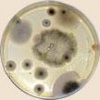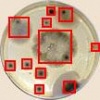This page is a part of the Computer Vision Wiki. The wiki is devoted to computer vision, especially low level computer vision, digital image analysis, and applications. The exposition is geared towards software developers, especially beginners. The wiki contains discussions, mathematics, algorithms, code snippets, source code, and compiled software. Everybody is welcome to contribute with this in mind - all links are no-follow.
Main Page
From Computer Vision Wiki
←Older revision | Newer revision→
|
Computer Vision For Beginners: A Developer’s Platform
The current image analysis and computer vision technology is a very large collection of disparate “tools” in the form of “toolboxes”, “cookbooks”, or code libraries. It follows the following outdated manual paradigm:
Image analysis tools include “edge detection”, “thresholding”, “segmentation”, “Fourier transform”, “wavelets”, "the Laplacian of the Gaussian", and on and on, all drown in a sea of "image processing" tools. It takes long training and experience in this area to put these pieces together to create image analysis software. The methods are mathematically advanced at a level that goes well beyond what is covered in a typical undergraduate degree in computer science: Fourier and wavelet transforms, partial differential equations, probability and statistics, discrete topology and geometry, etc.
Over the last few years, the fast growth of digital imaging has created the demand for image analysis systems that are both cheap and versatile. Platforms for such systems should allow the software developer to concentrate on the user’s needs and not on custom development of mathematical algorithms. Our goal is to take care of the "Mathematical tools" part above so that the developer would face this:
Of course we'll be able to handle only the fundamentals: objects in the image, their locations, measurements, their topology, etc. It is what may be called the low level computer vision. This data will allow the developer to concentrate on high level computer vision: what these objects represent in the context of his project.
For that we have our software developer's kit (SDK). If you also want to understand how everything works, this wiki gives you a unique chance. We have complete and detailed expositions and source code.
In fact, this wiki is self-contained...
Contents
- About this wiki
- Overview >> Objects in gray scale images >> Related approaches
- Topological image analysis >> Homology in 2D UC >> Homology UC
- Binary images
- What we are trying to find in the image >> Objects in binary images
- The cell decomposition of the image >> Cell decomposition of images
- Using cycles to partition the image >> Adding Pixels
- The pseudocode of the algorithm >> Algorithm for Binary Images >> Binary images - implementation
- The output of the algorithm >> Image Simplification
--> Homology in 2D UC
--> Image Sequences UC
- Grayscale images
- What we are trying to find in the image >> Objects in gray scale images >> Measuring objects UC
- The gray scale function of the image
- Thresholding >> Thresholding
- Counting objects in the sequence of frames >> Frame Graphs
- The pseudocode of the algorithm >> Algorithm for Grayscale Images
- The output of the algorithm >> Image Simplification
--> Color Images UC
- SDK UC << Objects in gray scale images
- Software projects UC << SDK UC
- Scientific image analysis
- Motion tracking UC << Image Sequences UC
- Stereo vision (stereopsis) UC << Image Sequences UC
- Watercolors UC
- Image manipulation UC
- Image search (visual image search) << Objects in gray scale images
- Image registration (image alignment) UC << Objects in gray scale images
- Industrial quality inspection (machine vision) UC
- Character recognition (OCR) UC
- Cell counting (microscopy) UC
- Homology in 2D UC << Linear algebra UC
- Homology UC << Linear algebra UC
- Color Images UC
- Image Sequences UC
"UC" means "under construction".
"<<" indicates dependency (and so does a lower position - to some degree).
">>" indicates suggested reading.
"-->" means that you can jump to that article.
Slides: A Short Introduction
Digital discoveries
- Casinos Not On Gamstop
- Non Gamstop Casinos
- Casino Not On Gamstop
- Casino Not On Gamstop
- Non Gamstop Casinos UK
- Casino Sites Not On Gamstop
- Siti Non Aams
- Casino Online Non Aams
- Non Gamstop Casinos UK
- UK Casino Not On Gamstop
- Non Gamstop Casino UK
- UK Casinos Not On Gamstop
- UK Casino Not On Gamstop
- Non Gamstop Casino UK
- Non Gamstop Casinos
- Non Gamstop Casino Sites UK
- Best Non Gamstop Casinos
- Casino Sites Not On Gamstop
- Casino En Ligne Fiable
- UK Online Casinos Not On Gamstop
- Online Betting Sites UK
- Meilleur Site Casino En Ligne
- Migliori Casino Non Aams
- Best Non Gamstop Casino
- Crypto Casinos
- Meilleur Site Casino En Ligne Belgique
- Bookmaker Non Aams
- онлайн казино с хорошей отдачей
- スマホ カジノ 稼ぐ
- Trang Web Cá độ Bóng đá Của Việt Nam












